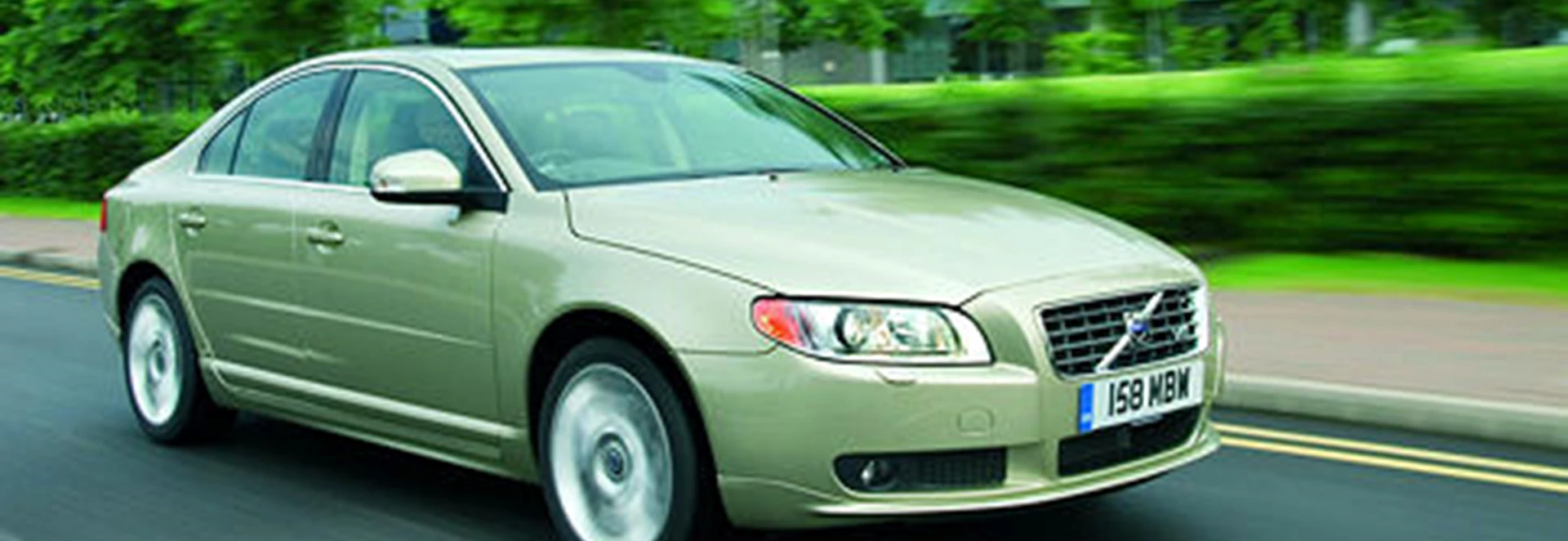I stood gazing at the S80 and discovered something about one of its details which I later realised also applies more generally to the rest of the car. This model, launched for the 2007 model year, is quite different in many respects from the first-generation S80 introduced in 1998, but despite a number of changes to the design it looks very similar. And frankly I had a bit of a problem with that, because I was never too keen on the appearance of the old car.It left me cold the first time I saw it, and it never improved no matter how much I stared at it. The new S80 is different. It's still not an exciting design - nobody who isn't directly or indirectly employed by Volvo will ever stop in their tracks and say, "wow, an S80!" - but if you take your time you'll gradually start to appreciate the way one part of the shape feeds elegantly into another. This isn't something you can force; you have to let the design come to you rather than expect it to grab your attention right from the start.The same applies to the way the car drives. Volvo says that the S80's set-up was developed on UK roads, and that the premium German makes - Audi, BMW and Mercedes-Benz - acted as the benchmark for handling. That's not apparent from behind the wheel. The S80 doesn't feel anything like any of its German rivals, and to begin with it can feel quite disappointing in comparison.That's what I thought, at least. In my first few miles with the S80 I drove it the way I normally do (and the way I would have driven - and have driven - Audis and BMWs and Mercs in similar circumstances). It seemed dull and lifeless and unwilling to deviate from a constant speed or direction without considerable persuasion.Disappointed by this, I started driving more slowly, and suddenly the S80 came alive. It refused to hurry, but when I stopped being concerned about journey times the whole driving experience became much more fluid. If you like to press on, you won't be deviated from a preference for the German opposition, but if you take it easy the Volvo starts to make a lot of sense as a car with a true luxury feel.It helps that the S80 is particularly comfortable, with excellent seats and major controls which take roughly the same amount of effort to operate. Even the gearchange, which was a horror story on the old S80, is more positive and less rattly nowadays. All that's needed to complete the picture is a proper resting point for your left foot - the one Volvo uses at the moment is too thin, and doesn't let you support your weight on it as it should.Interior room was very good on the previous S80, and it's even better now, thanks partly to the fact that the new car is slightly wider and taller than the old (though the overall length hasn't changed). Luggage space, on the other hand, is only moderate for a car of this size at 422 litres, and as with other Volvos access isn't great either, not least because the boot opening is much narrower than the boot itself.It's hardly worth mentioning, given Volvo's long-standing commitment to this sort of thing, that the S80 has a remarkable number of safety features, both active and passive, or "preventive" and "protective" as Volvo puts it. These include a new type of side airbag, swivelling bi-xenon headlights and a number of aids in the braking system.I'm happy to say that I wasn't aware of any of these during this test, but they are impressive enough for the US Insurance Institute for Highway Safety to give the S80 one of its 2007 Top Safety Picks awards (at the time of writing, Euro NCAP has not got round to putting the car through one of its own crash test programmes).There are five engines in the S80 range, and the one in the test car had the more powerful of the two 2.4-litre turbo diesels. This produces a maximum of 182bhp, but more importantly it's also reasonably quiet and produces most of its torque between 2000 and 2750rpm, which is probably the kind of rev range in which most owners are going to spend most of their time.The test car was an SE, which is the second of five trim levels. SE cars share the dual-zone climate control air-conditioning, powered door mirrors, cruise control, remote audio controls and iPod/MP3 etc auxiliary input of the entry-level S, and also have 17" alloy wheels, automatic mirror and wipers, an eight-speaker 160W audio system body-coloured front spoiler and side mouldings and an electrically-controlled driver's seat.Standard price for the SE is £26,495, but our car was worth £31,440 thanks to the inclusion of a communications pack (£2375), leather-faced upholstery (£1200), metallic paint (£575), a winter pack (£420), rear parking sensors (£350) and a passenger airbag cut-off switch (£25). Engine 2400cc, 5 cylinders Power 182bhp Fuel/CO2 44.1mpg / 169g/km Acceleration 0-62mph: 8.5 seconds Top speed 143mph Price £26,495 Details correct at publication date

Our Rating



